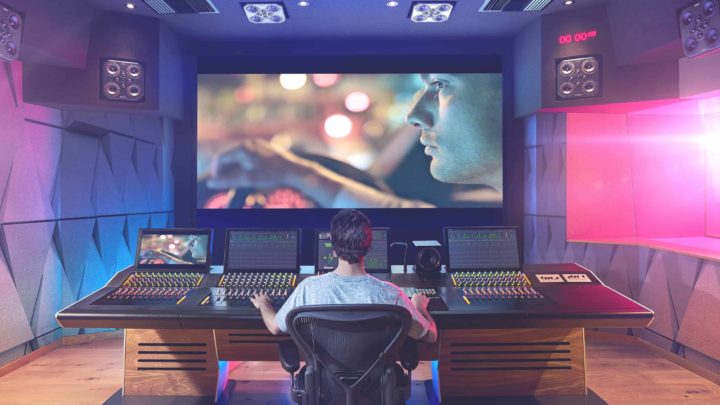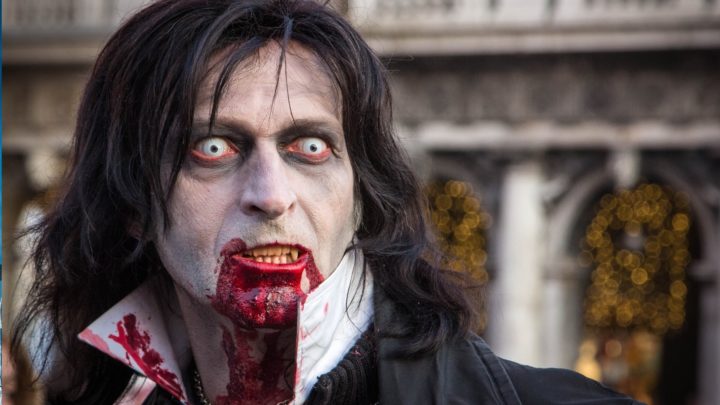Those outside the post-production flow might not have any idea what a colorist does. Those who do know that they’ve been bringing the world on the big screen come to life since Technicolor.
Whether you’re working at a post-production house and looking to move up or you’re just getting started coloring your pictures at home: here’s how you become a Hollywood colorist.
Color Grading vs Color Correction
You’re going to see the terms “Color Grading” and “Color correction” thrown around and might wonder what the difference is. They’re often used interchangeably, but they aren’t exactly the same thing.
Color correction is a type of color grading.
Color grading is adjusting the color of a film or video for any reason, technical or creative. This can include color correction, or it can include the various kinds of color grading discussed above.

An example of color grading
Color correction is adjusting the color of a film or video specifically to correct for mistakes or make it appear more natural or real. It actually starts on set, where the crew will adjust the camera for white balance.
Essentially telling the camera what color it should register as “white”.
You can do color grading and color correction in After Effects. You can do color grading and color correction in Premiere. But you probably shouldn’t try to color grade on set by messing with your white balance.
That’s your colorist’s job. You don’t want to put them out of work, do you?
What is the Colorist’s Job Description?
Colorists are post-production technicians who adjust the color, tint, and hue of the final product. They work alongside the director and the cinematographer to ensure the film or show looks exactly how the director wants it to.
In the old razor and tape days, this was done by changing the exposure time when developing film.
Thanks to computers and software like DaVinci Resolve, our methods have grown somewhat more sophisticated, and the definition of the colorist’s job has gotten broader.
Color Correction
Cameras don’t capture light the same way the human eye does. They get EVERYTHING, and even with the best cinematographer in the world, it can look over exposed to modern audiences.
Often times a colorist’s job is just to adjust the colors and the white balance to more closely match the colors we expect in reality -- color correction.
They might also adjust for slight problems in the film. Maybe a scene was lit incorrectly, maybe an actor looks more orange than they realized. Sometimes a director wants to change the lighting set-up of the film after the fact.
Essentially any form of color grading that brings the colors more into line with what was seen on the set that day, or what the human eye expects to see as “true”.
Color Grading
In the golden age of Hollywood, one of the most common uses of color grading was turning a scene shot in the daylight into a night scene, known as “day-to-night”.
It was a cost-saving measure -- shooting at night is notoriously difficult and expensive.
Maybe just turn everything slightly blue and hope the audience doesn’t notice.
These days, color grading is used more and more to produce artistic effects. A director might plan to wash his entire movie out to give it a bleak, post-apocalyptic look.

It's no surprise that brown and green clothing pop in the post- apocalyptic thriller, Children of Men (2006)
Alternatively, they might want to turn the colors up to eleven to make everything feel like a cartoon.
The color correction of Speed Racer (2008) can cause migraines, blurry vision, and in most cases, insanity
A director might want to highlight a certain mood.
Or even indicate the presence of a specific character. You can see this best in Netflix’s “The Defenders” mini-series.
Each superhero is associated with a specific color, and the scenes with those characters alone are always color graded accordingly.
If the colorist is doing their job, you won’t even notice. The finished product will just look “right” for the director’s vision.
What’s a Colorist’s Timeline?
The colorist doesn’t come in until the film has already been cut and the picture has been “locked” -- meaning there won’t be any additional changes made to the edit. Color correction is a time consuming process, and most productions can’t afford to color correct every cut.
The other reason is that most editing is done “off line”, or with a lesser quality copy of the video in order to save time and data space. A colorist needs as high quality a video as possible to load into DaVinci Resolve and do their work.
This can only happen once the video has gone “on line”, or the final cut has been transformed into a high quality video file.
This means the colorist is one of the last people to work on the movie before it’s released. They’ll start off with a session with the director called a “spotting session” to make sure everyone is on the same page, and then it’s just them and their white balance tool.
How to Color Correct
These days, modern technology has put a lot of the most basic tools of color correction into everyone’s hands. However, just having access to a laptop with Photoshop won’t cut it if you want to make a career.
1. Have the right equipment
Film has come a long way since the days of the telecine. It’s increasingly rare that a colorist will color correct anything that was actually shot on film.
As filmmaking has moved into the digital age, the tools of color correction have moved into the digital space as well. The first tool a good colorist is going to want is a good computer.
Eventually as your career progresses (or you find yourself set up at a nice post production house) you’ll want to work on a specialized mixing consoles.
Especially tech savvy colorists will even craft their own custom-built rigs for the best performance.
Check the software requirements, but when you’re starting out, most modern computers can handle color correction in Premiere and After Effects.
Even more important than the computer, though, is a good color grading monitor.
Professional colorists do their white balancing with elaborate projection set-ups designed to mimic a movie theater.
The screen with your laptop isn’t going to cut it. You need a high definition color grading monitor. Possibly even 4K if you can afford it.
You’ll be judged by the sharpness of your color correction by people who do own professional color grading monitors.
As a bonus, you can list the equipment you have access to on Production Beast -- this will help you land jobs when you finally go freelance.
2. Download Quality Software
Of course, all that hardware is meaningless if you don’t have the software to back it up.
You can color correct in After Effects and Premiere, and indeed most modern editing software has some kind of color correction or white balance feature pre-built into it.
It’ll get the job done for a student flick, but if you want to work on the high end level, you need to invest in specialized color software like DaVinci Resolve.
Fortunately, the basic version of DaVinci Resolve is currently free to download and use. The studio version costs a cool $299, but you can wait on that until you’ve got a little extra cash in your pocket.
Or access to a studio’s deep pockets.
Ideally, though, you’ll ultimately want to start off with the software you’re most comfortable with. DaVinci Resolve is the industry standard, so you’ll want to master it sooner or later.
But starting off, it’s more important that you work with something you’ve mastered.
3. Develop A Particular Set of Skills
First and foremost, a colorist has to be a good communicator. You aren’t balancing the colors to create the most beautiful still frame.
You’re balancing them to realize the director’s vision, which itself serves the needs of the story.
It’s not enough to just follow their commands -- you have to understand why they’re being issued in the first place. To point out things they may not have thought of.
To be able to operate when they aren’t there.
But being a colorist is also a highly technical job.. Your knowledge base should include:
- Familiarity with the major softwares used for color correction: After Effects, Premiere, and DaVinci Resolve, among others.
- A technical understanding of how light interacts with digital cameras
- Knowing what realistically can be done in the post-production process.
- An understanding of basic color theory and
- How color affects the human mind.
Most colorists are people who have spent a lot of time color grading on their own.
Think the kind of people who need to fuss over every vacation picture so it looks perfect. Who check the white balance when taking a photo of their meals.
4. Continue Your Education
While you don’t have to have a degree to be a successful colorist, most have an artistic educational background. It’s easy to learn software, but a deep understanding of light and color requires more training.
It’s not uncommon for colorists to have art degrees, film degrees, or no degree at all.
Even after you’ve started working, though, it’s important to keep your skills fresh.
The International Colorist Academy offers classes on a variety of color grading topics year-round in Los Angeles, New York, Sydney, London, and Singapore. They even offer a weeklong summit every year full of classes.
These classes are worthwhile even if you already know your way around color correcting in After Effects. It’s important to keep your skills fresh and stay up-to-date on the latest software.
5. Practice, Practice, Practice
If you’re still working as a post-production assistant, with dreams of getting into the coloring room, a great way to start is practicing on your own with still images.
The principles of color grading apply to photos as much as they do to film, and it’s easy enough to start with a simple white balance.
If you’re not sure how to start, there are youtube tutorials available to start learning how to color correct in After Effects, Premiere and other software set-ups. Once you get the basics of the software down, you can start applying your own understanding of color theory.
And good news. Youtube has you covered on that front too.
Either way, you’ll learn best by doing, trying new techniques, making mistakes, and building a portfolio of work you can use to showcase your talent.
How to Make a Living as a Colorist
Of course, obtaining the skills and tools of the professional colorist is only the first step. The difference between professional colorists and hobbyists is that professional colorists have turned color grading into their career.
1. Work at a Post Production House
A good place to snag your first job is at a post production house: a studio that specializes in performing post production services (such as foley or editing) for finished films.
These post houses will have access to sophisticated software and hardware that you won’t be able to get anywhere else. Want to white balance with DaVinci Resolve on a Blackmagic console using a 4K-quality projector?
Not a lot of places will give you that opportunity.
Working a post production house usually means starting low on the totem pole, possibly even as a humble production assistant. You can research job offerings at post production houses on Production Beast, but it’s also good to research companies and reach out to them directly.
They may have internships available, or be willing to take you on even if they aren’t actively looking for anyone.Once you have that first job, follow the basic rules of good assistanting. Ask to help the colorists and ask them lots of questions.
Learn their secrets. Get in their good graces. Maybe get hired as their assistant colorist.
2. Build a Reel With Smaller Projects
No one starts out coloring “The Avengers.”

Although it's easy to see why you want to. The colorists on The Avengers (2012) do great work.
Fortunately, there are many independent productions out there you can use to build a reel.
Many independent productions, especially shorts, may not have thought they could afford a colorist. Some may not even be aware that a colorist is something they need.
With Production Beast, you can keep see upcoming shoots in your area that are staffing. If they’re a short, or a first time filmmaker, reach out and message them. Ask if they’ve thought of hiring a colorist.
They may surprise you.
3. Find Your Peers
As we mentioned, colorists are represented by the MPEG. Aside from determining fee minimums, the MPEG also gives you access to their health and pension programs.
There are also other benefits, such practice facilities to keep your skills sharp in between gigs with the funds to rent you post house time.
Of course, as with all guilds, this also comes with certain responsibilities.
Aside from paying your union dues, you will also be expected to participate in your union’s collective actions. Company gets blackballed? You’re not white balancing anything for them.
IATSE decides to go on strike? Pick up your sign and get to chanting.
Membership is based on work experience. As of 2017, colorists and assistant colorists need 100 days of non-union work experience within two years to apply. So get to working.
The internet is also a wonderful place to find your peers and seek their help and advice. We already touched on the helpfulness of youtube tutorials, but there are also vibrant post production communities, like LiftGammaGain, that you can join.
How Much Green is There in White Balance?
If you’re on the payroll of a standing post production house, they will likely set the rates for you, which will include your fee along with covering any overhead. 4K projectors and the studio version of DaVinci Resolve don’t pay for themselves!
If you’re a freelancer, however, you’ll likely want to work out your hourly and day rate. Some colorists offer flat rates, but those are best suited to larger projects with big budgets you can negotiate in advance.
The advantage of charging by the hour or day is that it covers your bases regardless of the complexity of the job. Simple white balances and color correction can be knocked out quickly and will thus cost less.
Complicated color grading with heavily edited footage will take longer and cost more. Either way, you’re being paid in accordance with the amount of work you do.
Join the Local 700
The Motion Pictures Editors Guild (also known as the MPEG or IATSE 700) is part of IATSE and represents the interests of all post-production professionals in negotiations with studios, including colorists.
As part of those negotiations, the MPEG sets minimums (sometimes known as scale). MPEG members cannot be paid, or accept payment, below those minimums, which vary depending on the type of project being done.
If you haven’t yet joined MPEG, it will be on you to determine your rates based on the market. Some people will go as low as $10/hour, but we don’t recommend devaluing yourself that much.
One of the best ways to get an overview of what the market is paying is to look at the rates of your peers on Production Beast. Compare their experience and rates to your own and make a judgement from there.
And while you’re looking at people to compare salaries to, you should also consider making a few friends.
The Finishing Touches
Color correction is one of those aspects of film people never realize is there. It is often something that starting filmmakers may not even realize that they need.
But seasoned vets of the industry will tell you -- it makes all the difference in the world.
Working colorists, did we miss anything? What’s your favorite color grading job that audiences might never realized was there? Tell us about it in the comments below.
Like this post? Share it!
"How to Work in Color Correction and Actually Make a Living" #filmmaking #filmmakers







And live in the arms of that fictitious Adonis that you’ve conjured because your fantasy mate.
Until you get your feet under you, you have to minimize the info you eat, and TV news is the
first to go. Over the arrival months I’ll be writing
a series of articles revealing the secrets to public relations (all
the stuff a journalist really doesn’t would love you to
know.